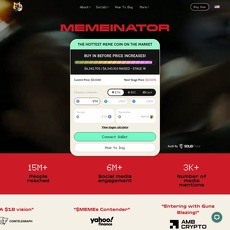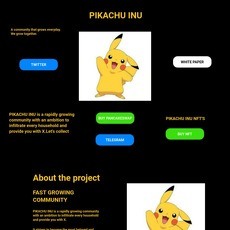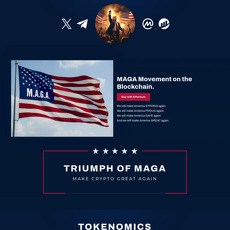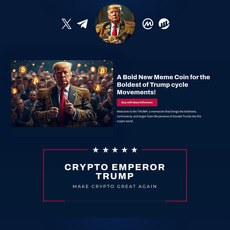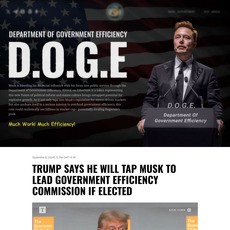Wawe Swaps Review
Wawe Swaps
waweswaps.global
If your website is on the scam list and you think that you are not a scammer, contact us. After you provide us with all the proof that you are in Crypto World with good intentions, we will delist you. Usually, you get in this category because you are hiding your team, you have a bad reputation(you are tricking, deceiving, scamming people), and you haven't got a written project whitepaper or is a shitty one....
Their Official site text:
Whitepaper
June 15th, 2023
Milan Kozlevcar
https://twitter.com/milankozlevcar
Legal Disclaimer: The information contained in this cryptocurrency whitepaper is for
general informational purposes only. It is not intended as financial or investment advice,
nor does it constitute an offer or solicitation to buy or sell any securities or digital assets.
The content provided in this whitepaper is based on the current understanding and
knowledge available at the time of writing. The cryptocurrency market is highly volatile and
subject to rapid changes. Therefore, the information presented here may become outdated
or inaccurate over time.
Investing in cryptocurrencies involves risks, including but not limited to market volatility,
regulatory changes, and technological risks. Past performance is not indicative of future
results, and there is no guarantee of the success or profitability of any particular
cryptocurrency project or investment strategy.
Readers are strongly advised to conduct their own research and due diligence before
making any investment decisions. It is recommended to consult with a qualified financial
advisor or professional before engaging in any cryptocurrency investments.
The authors, contributors, and publishers of this whitepaper disclaim any liability for any
loss or damage, directly or indirectly, arising from reliance on the information provided
herein. They do not assume responsibility for any financial or investment decisions made
based on the contents of this whitepaper.
This whitepaper may contain forward-looking statements or projections regarding future
events or performance of cryptocurrencies or related technologies. Such statements are
subject to various risks and uncertainties, and actual results may differ materially from
those expressed or implied in such statements.
The use of any trademarks, trade names, or third-party logos mentioned in this whitepaper
does not imply endorsement or affiliation with their respective owners. All trademarks,
trade names, and logos belong to their respective owners.
This legal disclaimer is subject to change without notice. By reading this whitepaper, you
acknowledge and agree to the terms and conditions outlined herein.
Table of Contents
Introduction: About Crypto White Papers .......................................................................... 1
Today's World of Cryptocurrencies in a Nutshell ................................................................ 2
Enhancing the Security of the Cryptocurrency Ecosystem........................................................... 3
Cryptocurrency Regulation – what would be the purpose? ........................................................ 3
Smart Contracts and Their Power of » Self-regulation « ............................................................. 5
DAO Voting Mechanisms ........................................................................................................... 6
Cryptocurrency ecosystems................................................................................................ 7
BNB Smart Chain........................................................................................................................ 7
Pancakeswap............................................................................................................................. 8
Cryptocurrency Liquidity.................................................................................................... 8
WaweSwaps.global [GBL].................................................................................................. 9
Global Token (GBL) .................................................................................................................... 9
Tokenomics for GBL Token:.......................................................................................................10
GBL DAO – community involvement .........................................................................................11
Terminology related to the use of the WaweSwaps interface....................................................12
Cryptocurrency Ecosystem's Ecology.........................................................................................12
GBL Token swap........................................................................................................................13
WaweSwaps - Relation with Cryptocurrency Regulations.........................................................13
Roadmap and vision .................................................................................................................14
Roadmap for Enhancing the Security of the Cryptocurrency Ecosystem ....................................14
Conclusion....................................................................................................................... 16
1
Introduction: About Crypto White Papers
General: A crypto white paper is an informative document used to promote goods or
services and provide a comprehensive analysis of a specific topic. In the case of
cryptocurrencies, white papers focus on virtual currencies, offering an overview of the
coin or token, details about the project's team, technology, and development roadmap,
as well as in-depth information about the coin or token economy. These white papers
can range from several to dozens of pages.1
Bitcoin: One of the most significant cryptocurrency white papers is the one published for
Bitcoin, titled 'A Peer-to-Peer Electronic Cash System Whitepaper.' It emphasizes the
concept of a purely peer-to-peer electronic cash system, enabling direct online payments
between parties without the need for intermediaries. While digital signatures play a crucial
role, the true benefits are undermined if a trusted third party is still required to prevent
double-spending.«2
WaweSwaps (GBl)│Overview and Principles: The whitepaper offers a
concise yet comprehensive overview of the cryptocurrency ecosystem. It
delves into market capitalization and the proportions of major crypto assets,
exploring the need for safeguarding and regulating cryptocurrencies. It
highlights the power of DAOs (Decentralized Autonomous Organizations)
for transparent and fair consensus.
Additionally, the whitepaper provides a summary of the Binance Smart
Chain network and PancakeSwap, a popular decentralized cryptocurrency
exchange. By emphasizing liquidity, the whitepaper concludes that the top
10 liquid crypto-assets represent 85% of the total market, while many others
lack liquidity. Waweswaps proposes a fair and transparent solution to
remove illiquid tokens, promoting sustainability and transparency in the
ecosystem.
The introduction of the WaweSwaps platform, managed by two essential
smart contracts on the Binance Smart Chain (GBL Swap and GBL DAO),
aligns with these principles. Ultimately, this whitepaper conveys the
fundamental principles of cryptocurrencies, including trustless trust,
individual empowerment, and control over assets, data, and identity. The
idea of WaweSwaps and the GBL token is succinctly captured in a few
chapters due to its straightforward nature.
1 https://bitscreener.com/whitepaper, 29.05.2023. 2 https://bitcoin.org/bitcoin.pdf, 29.05.2023.
2
Today's World of Cryptocurrencies in a Nutshell3
3 Source: https://coinmarketcap.com/charts, 29.05.2023.
Market Cap Bitcoin
Ethereum
Tether
BNB
USD Coin
XRP
Cardano
Dogecoin
Polygon
Solana
Others
The left and above graphs are the
representation of the percentages
of the individual proportions of the
largest ten crypto-assetsrelative to
the total market capitalization of
all assets. Since BTC was the first
asset, it has remained the largest
by market cap, which is why its
dominance in the market is a
number that many people follow.
We describe the assets tracked in
this chart as crypto-assets,
including tokens and stablecoins.
Total Cryptocurrency Market Cap
The graph below represents historically recorded cryptocurrency's market capitalization which is determined by
multiplying its current price by the total number of coins or tokens in circulation. Bitcoin had a market
capitalization of $1.2 billion on May 1, 2013. It took bitcoin nearly nine years from the date of its creation to reach
the $100 billion mark, when it reached $100.1 billion in market capitalization on October 21, 2017.
3
Enhancing the Security of the Cryptocurrency Ecosystem
The cryptocurrency market's volatility and the collapse of the FTX exchange
have prompted regulators to implement stronger regulations. The ECB has
finalized the Regulation of Markets in Crypto-Assets (MiCA) to harmonize
regulations across the EU. The Federal Reserve aims to restrict
cryptocurrency banking activities. While regulations are necessary, finding
the right balance between regulation and innovation is crucial. The EU has
approved the Markets in Crypto Act (MiCA), establishing the world's first
comprehensive regulatory framework. These regulations will enhance
transparency, trust, and risk management. Striking a balance is essential to
ensure a safe environment for crypto enthusiasts and investors.4
Cryptocurrency Regulation – what would be the purpose?
From the perspective of individual consumers, who strive to live
purposefully and develop their identities, talents, and contribute to their
communities prosperity, it is evident that the global economy is
unbalanced. Globalization has brought us a "marketing" era where goods
are produced and distributed on a regional and global scale. In this profitdriven system, consumers are increasingly dependent and powerless,
lacking the means to protect their assets, privacy, and identity.
Large corporations have become a dominant force in today's globalized
world, impacting billions of lives in intricate and often unnoticed ways.
While some view these corporations as beneficial, promoting economic
growth, job opportunities, and affordable quality products, others see them
as exploitative, exerting control over public policy, damaging the
environment, and eroding cultural values. It is undeniable that global
corporations have an unavoidable presence in our modern society and will
continue to be so. The crucial question is not whether corporations should
have a significant role in our economy and society, but rather how their
behavior aligns with broader societal goals, encompassing economic and
non-economic objectives. Cryptocurrency, through democratically agreed
consensus, holds the potential for significant evolutionary progress for both
humans and nature. As outlined in the Bitcoin Whitepaper, its peer-to-peer
technology facilitates direct online payments without intermediaries. This
presents us with an opportunity to make substantial strides toward global
sustainability, benefiting our lives and those of future generations. The
4 https://www.cnbc.com/2023/04/20/eu-lawmakers-approve-worlds-first-comprehensivecrypto-regulation.html, 29.05.2023.
4
consequences of our actions in this moment will determine the legacy we
leave behind and the price humanity and the planet will pay.
Introducing a democratically based model of DAO voting and decisionmaking, supported by smart contracts, offers a fair and transparent
mechanism where every participant contributes to the collective outcome.
This model transcends national boundaries, avoiding the shackles of slavery
and manipulation. It operates through self-regulation, transparency, and
public participation.
History teaches us valuable lessons, including the recognition that natural
processes often lead to patterns known as economic bubbles. Business
cycles, linked to technological innovations, create phases of investment,
market growth, and employment opportunities. However, as the
technology matures and markets become saturated, expansion slows
down, and recessions become likely a corrective measure to eliminate
excessive investment or capacity. Recession is a normal condition in a
market economy as it regulates excesses, bankrupting weaker players or
those with high leverage. However, central banks, such as the Federal
Reserve, seem to exacerbate bubbles and the manias driving them. By
providing excessive credit and failing to intervene when necessary, they
disrupt the natural order. Instead of market-regulated economic stability,
monetary intervention creates long-term instability in pursuit of short-term
gains. Bubbles, or financial manias, unfold in multiple stages, a pattern
observed throughout 500 years of economic history. Although each mania
is distinct, similarities persist. In simple terms, we can identify four phases
(see graph).5
5 https://transportgeography.org/contents/chapter3/transportation-and-economicdevelopment/bubble-stages, 29.05.2023.
5
Cryptocurrency regulation should adhere to general principles of law,
widely followed across nations, such as good faith, estoppel, and equity.
Legal norms must protect those who need them most and should not serve
powerful and monopolistic corporations, particularly when human rights
are at stake. Individuals' freedom to control their assets, data, and identity
should be safeguarded.
These are the essential reasons why the world of cryptocurrencies require
regulation. However, this regulation should be founded on principles of selfregulation, open consensus, the common good, and improved quality of life
for all stakeholders.
»The DAO model, empowered by smart contracts, offers the
means to achieve these goals!«
Smart Contracts and Their Power of » Self-regulation «
In order to effectively regulate anything in the world, we must have control
over the environment where these regulations will be implemented.
Attempting to regulate the deployment and execution of smart contracts
worldwide without a blockchain network operated by an independent
authority with clear, pre-designed rules and protocols is both misguided
and ineffective, and it goes against fundamental human rights.
The numerous decentralized applications that facilitate asset exchange
through "regulated" providers from the mainstream economy would in the
first place clash with the transformative potential that cryptocurrencies
offer in our lives. Do we truly need an additional set of rules to treat
cryptocurrencies as just another form of stocks, bonds, or commodities? Or
should we focus on treating cryptocurrencies as they are, while promoting
and educating users about the advantages of being their own authority and
safeguarding their privacy and identity instead of becoming dependent on
the system?
Cryptocurrencies are not issued like other financial instruments; instead, all
essential details about a "cryptocurrency" or "token" are set by deployed
smart contracts. The deployment of smart contracts is accessible to
everyone without the need for approval or licensing from a central authority.
»In conclusion, regulations that fail to consider the
aforementioned facts, among others, will only perpetuate
ineffective practices from the mainstream economy that
cryptocurrencies have the potential to overcome.«
6
DAO Voting Mechanisms
DAOs are decentralized organizations controlled by their members, using
blockchain-powered smart contracts for transparency and trust. Various
voting mechanisms exist to facilitate decentralized decision-making and
community participation.6
TOKEN-BASED QUORUM VOTING requires a specific number of members to
participate for a proposal to pass.
PERMISSIONED RELATIVE MAJORITY focuses on "for" and "against" votes without
a minimum requirement.
RAGE QUITTING incorporates sponsorship and a grace period for voters to
withdraw support.
QUADRATIC VOTING ties voting power to financial power.
CONVICTION VOTING aggregates community preferences over time.
HOLOGRAPHIC CONSENSUS combines prediction and betting.
MULTISIG VOTING balances central authority and decentralization.
LIQUID DEMOCRACY delegates voting power to trusted experts.
»While no perfect solution exists, each mechanism has its
advantages and challenges. As blockchain technology
advances and DAOs evolve, new voting mechanisms may
emerge or existing ones may be combined for better
solutions.«
6 https://limechain.tech/blog/dao-voting-mechanisms-explained-2022-guide, 29.05.2023.
7
Cryptocurrency ecosystems
Web3 ecosystems, including projects like DeFi, NFT, and DAOs, offer new
opportunities for entertainment, employment, education, shopping, etc. It
is important to recognize how and why would these projects operate in
separate cryptocurrency ecosystems rather than within the mainstream
economy.
Unlike popular belief, governments do not control the global economy; the
power lies with large banks and corporations. Cryptocurrencies, based on
blockchain technology and cryptography, provide decentralized digital
money outside the control of a central authority.
Understanding blockchain, decentralization, and cryptography is key to
comprehending cryptocurrencies. Cryptocurrencies have evolved since
Bitcoin's introduction in 2009, with various blockchain protocols like Stellar,
Ethereum, and Binance Smart Chain emerging in the market.
While cryptocurrencies have advantages such as anonymity and lower fees,
challenges like price volatility and lack of regulation exist. Integrating
cryptocurrency ecosystems into the mainstream economy requires
addressing these challenges and adapting existing financial systems.
To create a sustainable business environment, improving understanding,
knowledge, and practices surrounding cryptocurrencies is crucial.
»Sustainable practices and transparent business models can
be fostered by recycling unwanted tokens through platforms
like WaweSwaps, ensuring a clean and efficient economic
environment for future generations.«
BNB Smart Chain
Two blockchains, the "BNB Smart Chain" (BSC) and "Beacon Chain" (BC),
exist in the BNB Chain ecosystem, providing different services. While BC is
a high-speed blockchain, it lacks smart contract functionality. To address
this, BSC, a parallel blockchain, is proposed to support smart contracts
without compromising BC's performance. BSC operates independently and
aims for Ethereum compatibility, allowing existing applications and
communities to seamlessly transition. Staking-based consensus and
governance enhance network performance and environmental friendliness.
Both chains will have native cross-chain communication, facilitating
trustless asset transfers while minimizing other blockchain state items.7
7 https://github.com/bnb-chain/whitepaper/blob/master/WHITEPAPER.md, 29.05.2023.
8
Pancakeswap
PancakeSwap is a decentralized exchange on Binance Smart Chain, offering
faster and low-cost transactions compared to Ethereum. It operates using
an Automated Market Maker (AMM) model, where users contribute to
liquidity pools and earn LP tokens as rewards. Launched in September 2020,
PancakeSwap gained popularity due to its advantages over Ethereumbased platforms, including faster transactions and lower fees. It provides
multiple avenues for profit, such as trading, yield farming, staking, NFTs, and
lotteries. Competitors include UniSwap, 1inch, and SushiSwap.
PancakeSwap has its native token, CAKE, used for governance and rewards,
and plans for future development, including new features and expansion to
other blockchains.8
Cryptocurrency Liquidity
Cryptocurrency Liquidity is a term used to describe how easily an asset can
be bought or sold. In the context of cryptocurrency, liquidity refers to the
ease of exchanging tokens for other tokens or fiat currencies. High liquidity
means there is a large pool of potential buyers and sellers, resulting in a
stable market with low price changes.
A liquidity crisis in crypto occurs when there's a lack of cash or assets,
leading to platform failures, bankruptcies, and frozen withdrawals..
Liquidity problems can arise when liquidity sources are depleted or come to
a halt, such as when a bank freezes credit lines or financial institutions
experience shortages. These problems can cause a domino effect,
increasing interest rates and devaluing assets.
A liquidity crisis affects investors with frozen withdrawals and trapped
assets. It is important to research and verify the liquidity of tokens before
investing, like NeferuCrypto - they notify users via their Telegram channel
when liquidity is added or locked.
Increasing liquidity in the crypto market is influenced by the growth and
popularity of the community. As more people invest and trade
cryptocurrencies, the liquidity of crypto assets improves too. However, low
liquidity levels can result in market volatility and difficulty in buying or
selling assets quickly.
Overall, liquidity is a vital aspect of the cryptocurrency market, affecting the
ease of transactions, market stability, and investor confidence.9
8 https://coindcx.com/blog/cryptocurrency/pancakeswap-whitepaper-summary, 29-
05.2023.
9 https://cointelegraph.com/learn/what-is-a-liquidity-crisis-and-what-does-it-mean-forcrypto-investors, 29.05.2023.
9
WaweSwaps.global [GBL]
WaweSwaps' mission is to provide and enhance liquidity within the
cryptocurrency ecosystem, catering to already liquid, less liquid, or even
illiquid tokens. The platform integrates the following features:
1. Principles of "crypto-mining" by rewarding users with new emissions
based on their activities.
2. Utilization of an Automated Market Maker (AMM) mechanism
through algorithmic "money robots" to ensure proportional
distribution of liquidity for all token swaps.
3. Decentralized cryptocurrency exchange empowering users with
control over their assets, privacy, and data.
4. Built on the Binance Smart Chain, specifically designed for swapping
BEP-20 tokens.
5. Adoption of a DAO voting decision-making model, involving all users
in the interaction.
The platform will be launched on June 26th, 2023, in the UAE.
The team comprises a lead IT developer, a business operations developer,
and a founder. The founder and author of this whitepaper is the official
representative of WaweSwaps. He also provides advisory support and leads
the team.
Global Token (GBL)
The Global Token (GBL) is designed for global circulation and usage. It
operates on the Binance Smart Chain network and has a fixed supply
without the possibility of additional minting or burning. The distribution of
GBL tokens is determined through WaweSwaps mechanisms, which
incorporate the well-known "halving" protocol. The VGBL tokens held in the
DAO pool provide decision-making power and management capabilities.
A maximum of 17.9 million GBL tokens will be in circulation and held by the
public, influencing the calculation of the GBL token's Market Cap.
10
Tokenomics for GBL Token:
1. Token Name: Global Token (GBL).
2. Token Standard: BEP-20 (on the Binance Smart Chain network).
3. Token Contract Address: 0xC14A7747cFec02CfeA62E72BB93538DE6B2078E6
4. Total Supply: 17.9 million GBL tokens.
5. Token Distribution:
• Token Sale: Liquidity Providing (from 15.06.2023 to 25.06.2023),
• Token Sale price and on PancakeSwap: 1.00 USDT / 1.00 GBL,
• Halving Events and Reward Splitting:
• 8.95 M GBL distribution, 64% reward based on Swap LP,
• 4.475 M GBL distribution, 32% reward based on Swap LP,
• 2.2375 M GBL distribution, 16% reward based on Swap LP,
• 1.11875 M GBL distribution, 8% reward based on Swap LP.
6. GBL DAO - Community Involvement:
• Membership Model: Token-based,
• DAO Token: VGBL,
• Voting Power: Held by VGBL token holders,
• Decision-making: Voting on exchange rates and future
utilization of tokens in the GBL liquidity pool,
• Halving Mechanism: Algorithmically determined based on
swapping intensity, not time.
7. Liquidity Providing (LP):
• GBL Liquidity Providing required for creating a GBL Swap,
• Users need to provide swapping liquidity in GBL, equivalent to
the value of the swapping tokens,
• Liquidity ensures the processing of swapping orders and is
executed proportionally to all active GBL Swaps in the GBL
liquidity pool.
8. GBL Swap:
• Users can exchange listed tokens into GBL through the GBL
Swap feature on WaweSwaps,
• Swapping rate (Token/GBL) is determined by DAO members
and published on the platform,
• GBL Swap Value: The amount of GBL tokens collected in an
active GBL Swap before execution (100% higher than the value
of GBL Liquidity Providing for the specific Swap).
11
9. GBL Liquidity Pool:
• The wallet where all swapping activities and GBL Swap Liquidity
provisions are sent and managed according to the WaweSwaps
mechanism.
10. WaweSwaps Launch Date: June 26th, 2023.
11. Platform: Built on the Binance Smart Chain network.
12. Team: Lead IT developer, business operations developer and founder.
13. Official Representative: Author of the whitepaper, providing advisory
support.
14. Token Utility:
• Governance: VGBL holders can participate in DAO voting and
decision-making processes.
• Liquidity Provision: Users can provide liquidity in GBL to
facilitate token swapping.
• Swapping: GBL is used as an engine to swap listed tokens
through the GBL Swap feature on WaweSwaps.
GBL DAO – community involvement
Enabled by blockchain-powered smart contracts, DAOs are decentralized,
member-controlled organizations governed by computer-encoded rules.
There are two membership models for DAOs: token-based and share-based.
While tokens and shares were originally the primary forms of voting rights,
various DAO voting mechanisms have been proposed to ensure
decentralized voting and governance, encouraging broader community
participation in decision-making.
WaweSwaps DAO adopts the token-based membership model. It utilizes an
algorithm to distribute the total supply of GBL tokens into circulation as
rewards for WaweSwaps users. These rewards are halved at every 50%
milestone of the distributed GBL tokens. For instance, with a total supply of
17.9 million GBL until 50% distribution, WaweSwaps users will receive 64% of
the GBL liquidity providing value in their active GBL swaps. Later half less by
each of the 3 remaining halvings (4 halvings in total). The algorithm
determines the halving mechanism based on the intensity of swapping, not
time.
GBL DAO voters play a role in decision-making, particularly regarding
exchange rates and the future utilization of tokens collected in the
Swapping TOKEN pool.
12
Terminology related to the use of the WaweSwaps interface
1. GBL SWAP: An order to exchange a listed token into GBL.
2. SWAPPING RATE TOKEN/GBL: The exchange rate determined by DAO
members – published on the site for swapping (exchanging) tokens.
3. GBL LIQUIDITY PROVIDING (LP): When creating a new GBL Swap, users
need to provide swapping liquidity in GBL, equivalent to the value of
the swapping tokens. This liquidity enables the processing of the
swapping order, which is executed proportionally to all active GBL
Swaps in the GBL liquidity pool.
4. GBL SWAP VALUE: The amount of GBL tokens that will be collected in
an active GBL Swap before its execution. This value is 100% higher
than the value of the GBL Liquidity Providing (LP) for a particular GBL
Swap.
5. GBL SWAPPING PAIR: The token being swapped through the GBL Swap.
Token listings and their exchange rates are managed by DAO
members and approved through voting.
6. GBL LIQUIDITY POOL: The wallet where all swapping activities and GBL
Swap Liquidity provisions are sent and managed according to the
WaweSwaps mechanism.
7. GBL DAO POOL: The wallet where VGBL tokens from the GBL token
distribution mechanism are sent and managed according to the DAO
mechanism.
Cryptocurrency Ecosystem's Ecology
By utilizing the GBL Token swap feature on the WaweSwaps platform, you
can contribute to a cleaner and more efficient cryptocurrency ecosystem
while also benefiting from exchanging your liquid or less liquid, and unused
tokens. This functionality has an ecological effect, thanks to the integrated
proof-of-stake model that provides a user experience similar to proof-ofwork, but in an environmentally friendly manner. Unlike energy-intensive
cryptocurrency mining, the GBL Token swap operates sustainably.
Furthermore, it promotes maximum community involvement, ensuring
100% participation within a fully transparent, digital, and independent
ecosystem that offers equal opportunities for all.
13
GBL Token swap
The GBL Token swap feature allows you to contribute to a cleaner and more
efficient cryptocurrency ecosystem while also benefiting from exchanging
your liquid or less liquid, and unused tokens.
Using WaweSwaps is straightforward:
1. Ensure you have the desired number of listed tokens in your Binance
SmartChain wallet for the swap.
2. The algorithm will calculate the Liquidity amount in GBL tokens,
which you need to have in your wallet balance.
3. If you don't have the required amount, you can adjust the liquidity
value or purchase GBL tokens on PancakeSwap.
4. You'll need some BNB tokens to cover the network fee since
WaweSwaps operates on the Binance SmartChain network where
transaction fees are calculated in BNB.
5. Once your swap reaches 200% of the liquidity provided by GBL tokens,
it will be completed, and you can collect the accumulated amount to
use as you prefer.
By using WaweSwaps, you participate in GBL DAO, releasing undistributed
GBL tokens into circulation and becoming a member of the DAO.
WaweSwaps - Relation with Cryptocurrency Regulations
In terms of regulations, WaweSwaps, along with GBL Token swap, follows a
"Self-regulated" model.
It operates as a decentralized blockchain application where decisionmaking is organized through a community involvement system called DAO
(Decentralized Autonomous Organization).
When users participate in token swapping, they automatically become DAO
members and can increase their voting power based on their activities. The
unique aspect is that users can maintain their privacy without the need to
reveal more information than their public address.
Unlike the traditional transaction model that relies on limited access to
information between parties and a trusted third party, WaweSwaps publicly
displays all transactions.
This eliminates the need for a third-party trustee. Instead, users themselves
can ensure privacy by keeping their public keys anonymous, thus breaking
the flow of information at a different point.
14
Roadmap and vision
WaweSwaps follows a usability model that is likely unique but shares
similarities with established practices offered by DEX exchanges.
It's success and widespread adoption within the cryptocurrency community
will serve as a strong motivator for developers to explore and create similar
solutions.
WaweSwaps stands as the FIRST business model to present such solutions.
Our vision is to make the GBL smart contract accessible to anyone
interested in using the protocol and providing their own communities with
the GBL swapping protocol. All future development and activities will be
proposed and voted upon by GBL DAO members.
Roadmap for Enhancing the Security of the Cryptocurrency Ecosystem
Phase 1: Regulatory Framework and Transparency Enhancement
• Explore the provisions set by regulatory authorities to ensure
compliance with existing and upcoming regulations, such as MiCA in
the EU.
• Implement measures to enhance transparency and risk
management within the cryptocurrency ecosystem.
• Educate and inform cryptocurrency users about the benefits of
regulation and the importance of protecting their assets, privacy, and
identity.
• Establish a balance between regulation and innovation to foster a safe
environment for crypto enthusiasts and investors.
Phase 2: Self-Regulation and Decentralized Decision-Making
• Implement a DAO (Decentralized Autonomous Organization) model
empowered by smart contracts to enable self-regulation and
transparent decision-making.
• Explore different DAO voting mechanisms, such as token-based
quorum voting, permissioned relative majority, conviction voting, and
liquid democracy.
• Continuously evaluate and improve the chosen DAO voting
mechanisms to ensure fairness and efficiency.
15
Phase 3: Integration of Cryptocurrency Ecosystems
• Recognize and understand the separate cryptocurrency ecosystems,
including DeFi, NFT, and DAOs, and their advantages over the
mainstream economy.
• Address challenges such as price volatility and lack of regulation to
integrate cryptocurrency ecosystems into the mainstream economy.
• Foster sustainable practices and transparent business models within
cryptocurrency ecosystems.
• Promote education and awareness about cryptocurrencies to
improve understanding and adoption.
Phase 4: Enhancing Cryptocurrency Liquidity
• Educate cryptocurrency users about liquidity and its importance in
the market.
• Research and verify the liquidity of tokens before investing.
• Support initiatives and platforms that enhance liquidity within the
cryptocurrency ecosystem, such as WaweSwaps.
• Monitor and address liquidity crises to ensure platform stability and
investor confidence.
Phase 5: Launch of WaweSwaps and GBL Token
• Launch the WaweSwaps platform on June 26th, 2023, in the UAE.
• Develop and implement the WaweSwaps features, including cryptomining rewards, Automated Market Maker (AMM) mechanism, and
decentralized exchange functionality.
• Introduce the Global Token (GBL) on the Binance Smart Chain
network with a fixed supply and distribution mechanisms.
• Involve the community in the GBL DAO for decision-making
regarding exchange rates and the utilization of tokens in the GBL
liquidity pool.
Phase 6: Continuous Improvement and Community Involvement
• Continuously improve the WaweSwaps platform based on user
feedback and emerging technologies.
• Engage the community in the DAO decision-making process and
encourage broader participation.
• Foster a collaborative and inclusive environment where stakeholders
can contribute to the improvement of the cryptocurrency ecosystem.
• Stay updated with regulatory changes and adapt the platform and
practices accordingly.
16
By following this roadmap, the cryptocurrency ecosystem can enhance its
security, transparency, and overall effectiveness while balancing regulation
and innovation. This will create a safe and sustainable environment for
crypto enthusiasts, investors, and the broader community.
Conclusion
In this whitepaper, we have presented WaweSwaps, a decentralized tokenswapping platform built on the Binance Smart Chain network. WaweSwaps
aims to provide users with a secure, efficient, and user-friendly environment
for exchanging tokens.
WaweSwaps leverages the power of blockchain technology to enable peerto-peer token swapping, eliminating the need for intermediaries and
ensuring transparency and trust in the swapping process. By utilizing the
BEP-20 token standard and operating on the Binance Smart Chain network,
WaweSwaps benefits from its fast transaction speeds, low fees, and
extensive ecosystem.
The key features of WaweSwaps include the GBL token, which serves as the
native utility token of the platform. GBL holders have the opportunity to
participate in the platform's governance through the GBL DAO, where
voting rights are granted based on the ownership of VGBL tokens. This
democratic approach allows the community to collectively make decisions
regarding exchange rates and the utilization of tokens in the GBL liquidity
pool.
Furthermore, WaweSwaps incentivizes liquidity providers by rewarding
them with GBL tokens, fostering a vibrant and liquid ecosystem. The GBL
Swap feature allows users to seamlessly exchange their listed tokens for
GBL, providing flexibility and accessibility to the platform's users.
WaweSwaps recognizes the importance of community involvement and
embraces the principles of decentralization. The team behind WaweSwaps
is dedicated to ensuring the platform's growth and success by continuously
improving its features, security, and user experience. With a lead IT
developer and business operations developer, WaweSwaps is committed to
delivering a robust and reliable platform that meets the evolving needs of
its users.
The launch of WaweSwaps is scheduled for June 26th, 2023, and we invite
token holders, traders, and liquidity providers to join us on this exciting
journey. WaweSwaps has the potential to become a prominent player in the
decentralized finance landscape, offering a reliable and efficient tokenswapping experience.
17
We would like to express our gratitude to our community for their support
and trust in the WaweSwaps project. We are confident that together, we
can revolutionize the way token swapping is conducted, empowering
individuals to take control of their financial transactions in a decentralized
and secure manner.
Join WaweSwaps and ride the wave of decentralized token swapping!
Disclaimer: This whitepaper is for informational purposes only and does not
constitute financial or investment advice. Users are encouraged to
research and exercise caution when participating in token swapping or
other activities on the WaweSwaps platform.


